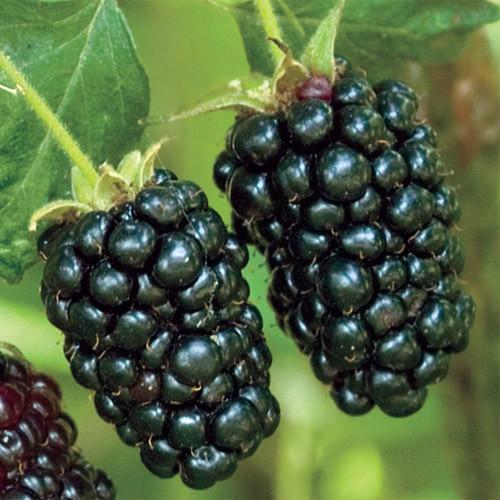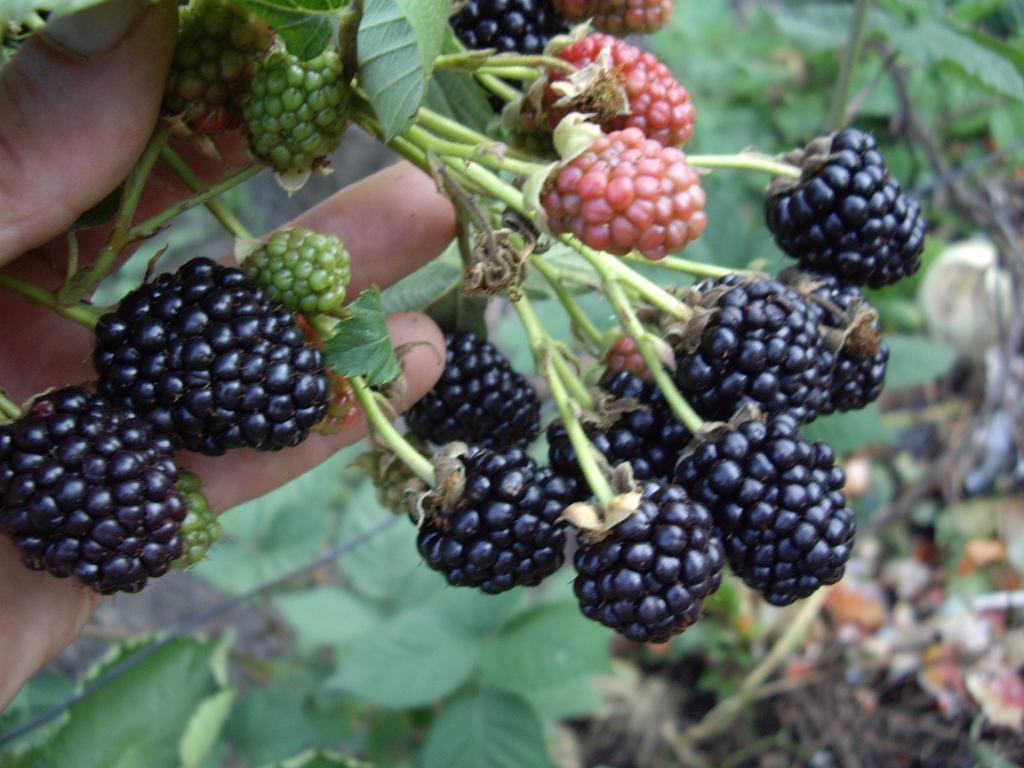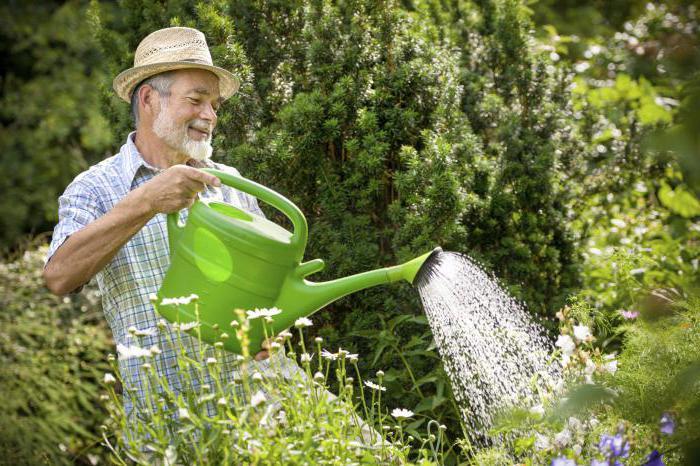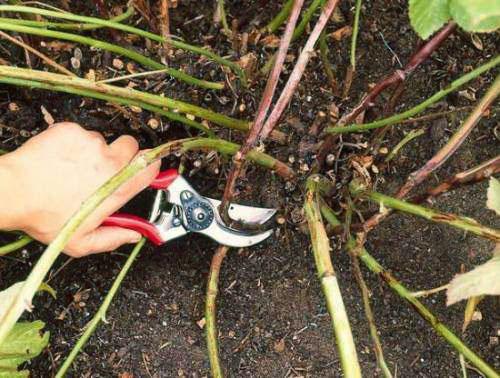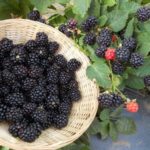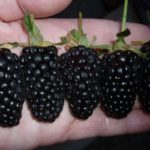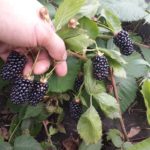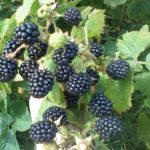Blackberries of the Prime Arc Freedom variety are a hybrid crop species bred in the USA. The plant has no thorns and bears fruit twice during the growing season. The variety is widely grown in Russia and other countries of the former USSR. For successful planting and caring for bushes, you should read the information below.
- History of appearance
- Description and characteristics
- Climatic conditions for growing blackberries Ark Freedom
- Berry quality, productivity of Prime Arc Freedom blackberries
- Disease resistance, frost resistance and drought resistance
- Basic pros and cons
- Subtleties of growing blackberries
- Deadlines
- Preparation of seedling material
- Selecting a location
- Prime Arc Freedom blackberry planting procedure
- Care instructions
- Watering blackberries
- Top dressing
- Weeding, loosening
- Preparing for winter
- Trimming
- Control of pathologies and pests
- Blackberry propagation methods
- Harvesting and storing blackberries Prime Ark Freedom
History of appearance
The blackberry variety was bred in 2013 in Arkansas, America, by breeder John Clark. The plant became popular in 2014. Hybrid blackberry Ark 45 includes many advantages and is superior in taste to the Navajo variety.
Description and characteristics
A remontant type of blackberry crop, Ark Freedom, has smooth, erect emerald-colored shoots. From the age of 3, they grow up to 3-4 meters in height. The fruits are large, 9-10 grams, oval-elongated with a rich aroma. The berries are moderately juicy, sweet, with slight sourness. Transportability is good, blackberries do not leak or deform during transportation.
Climatic conditions for growing blackberries Ark Freedom
The Ark blackberry variety is zoned for cultivation in the USA and California. In the climatic conditions of the center of Ukraine and the middle latitudes of Russia, it is better to plant bushes in greenhouses or tunnels.
Berry quality, productivity of Prime Arc Freedom blackberries
Blackberries are commercially available and are grown for the purpose of sale or personal consumption. They are dark purple in color, with pimply, smooth skin. The yield is high, up to 7 kg of berries are harvested from 1 bush, and up to 200 kg from 1 hundred square meters. When growing bushes in the garden, the berries are harvested in May and September. In a greenhouse, the plant blooms from February 15, and bears fruit once in April or early May.
Disease resistance, frost resistance and drought resistance
The Prime Arc Freedom blackberry variety is famous for its high resistance to pathologies and beetle infestations, provided proper care is taken.The bushes can withstand frosts down to -14 degrees and tolerate short-term droughts.
Basic pros and cons
The Prime Arc Freedom blackberry variety offers a number of advantages, but some gardeners have found disadvantages in it.
| pros | Minuses |
| High yield | Low winter hardiness |
| Presentable appearance of berries, excellent taste | Need for shelter |
| Undemanding to soil | The need for regular pruning |
| Shoots need support |
Subtleties of growing blackberries
2 weeks before planting, the ground is plowed with a shovel and the weeds are destroyed. Dig holes 40 cm in diameter. They should be 1 meter apart from each other, and maintain a distance of 2 meters between rows. Prepare a fertile mixture of 2 kg of humus, 40 g of potassium sulfate, 120 g of superphosphate. The combination is placed in the pits and left for 10-14 days.
Deadlines
It is optimal to plant Ark blackberries in the South in the fall, a month before the arrival of cold weather, around the beginning of October. In the middle and northern regions, planting work is carried out in late April, then the seedlings will have time to take root before frost.
Preparation of seedling material
Blackberry seedlings must be free of damage and beetle attacks, 1 year old, with 2 shoots at least 5 mm thick. The length of the rhizome is 10-12 cm. They are dipped in a solution to stimulate the growth of the root system Epin or Matador for 2 hours.
To disinfect seedlings, dip them in a low concentration manganese mixture.
Selecting a location
It is recommended to plant blackberry bushes in a place well lit by the sun, where there are no strong winds. In partial shade, the berries will not be as sweet.
Prime Arc Freedom blackberry planting procedure
2 hours before planting the bushes, water the prepared holes generously and wait until the liquid is absorbed. When planting, the root buds are deepened by 2.5 cm.Afterwards, the seedlings are dug in, watered abundantly, and the nearby soil is mulched with peat.
Care instructions
It is not difficult to care for the Ark blackberry; it requires regular watering, loosening, mulching, and treatment against beetles and diseases. The bushes are prepared for cold weather, pruned and fertilized.
Watering blackberries
Blackberry bushes are watered with settled water on average 2 times a week, depending on the weather. When the season is dry, 3 irrigations are required in 7 days. If it rains regularly, watering is carried out once a week.
Top dressing
In order for blackberry bushes to develop better and bear fruit, it is necessary to feed the plants during the phase of their active growth, in July, with nitrogen. The substance stimulates the growth of green mass. They also add organic matter, urea, in the amount of 20 grams or 4 kg per 1 square meter. Every year the earth is enriched with potassium at the rate of 40 g per 1 square meter. Nutrient mixtures should not contain chlorine.
Every 3 years, phosphorus is added once at a rate of 50 g per 1 square meter. If the soil is mulched with manure, the substance is not applied.
Weeding, loosening
Prime Arc Freedom blackberry bushes need to be loosened to destroy weeds and improve rhizome aeration. To facilitate the procedure, you can mulch the circle with sawdust or peat. A layer of mulch will also help conserve moisture.
Preparing for winter
After pruning and cleaning the area, you can cover the blackberry bushes with Prime Ark Freedom for the winter. The shoots are collected into a loose bunch, bent to the soil, tied to a support, and secured with hooks. To prevent the branches from being injured, they have been prepared since August by attaching weights. The bushes are covered with peat, sawdust, spruce branches, and agronomic fiber is placed on top.
Trimming
In March, remove damaged, frozen blackberry branches up to the first growth bud. In April, the bush is formed, leaving no more than 8 shoots. When they reach a length of 10 cm, the ends are shortened with disinfected pruning shears.
Control of pathologies and pests
Blackberry bushes are occasionally affected by fungi - septoria, anthracnose, purple spot, powdery mildew or rust.
- Septoria. The disease is characterized by beige-colored spots; subsequently, the leaves become lighter. The quality of the fruit deteriorates. You can get rid of the pathology by removing the affected part of the plant; the remaining bushes are treated with Alirin V, Gamair. When the buds open, they are irrigated with Bordeaux mixture 1%, Fitosporin.
- Anthracnose. Gray spots appear on the blackberries. The shoots crack, the berries fall off and dry out. To prevent the disease, manure and peat are applied under the bushes in spring and autumn. Infected parts are treated with fungicides.
- Purple spotting. The pathology is characterized by brown spots, the leaves dry out and die. The bushes are treated with Farmayod and fungicides.
- Rust. Small brown-yellow spots can be seen on the blackberries. Destroy pathology with copper-containing drugs.
- Gray plaque. The plants emit a foul odor and their growth is inhibited. Powdery mildew is removed with fungicides.
- Blackberry mite. After a pest attack, the crop stops ripening. The beetle is destroyed by two treatments with Akarin and Apollo with a frequency of 8-10 days.
- Zlatka. The disease affects the shoots, they dry out and die. To fight the pest, use Chlorophos, Metaphos, Karbofos.
Provided that blackberries are properly cared for, the risks of them being damaged by beetles and diseases are minimal.
Blackberry propagation methods
The Prime Arc Freedom variety is propagated by seeds, layering, and cuttings. Usually the events go well, even in the case of the seed method, it is possible to obtain a plant of the same variety.
- Rooting cuttings. Shoots of the Ark variety are bent to the soil and strengthened. At the places of fixation, earthen mounds are formed. Subsequent care involves regular irrigation and root trimming. The manipulation is carried out in April or November, but then the young bushes are covered. In the fall, the children are separated from the mother plant and transplanted into the garden.
- Root cuttings. Seedling material is prepared from blackberry roots. Shrubs are dug up and strong, elongated, healthy specimens 0.5 cm in diameter are selected. They are cut into pieces 10-16 cm long. The petioles should be rooted in August or September. Before planting, they are kept in a solution that stimulates the growth of the root system. Then, they are planted in separate containers with moistened soil. The roots should appear within a month, after which the plants are transplanted into the soil.
- Sowing seeds. Arc Freedom blackberry seeds do not germinate well, to speed up the process, scratch the dense outer shell or place them in the refrigerator for 7 days. They resort to manipulation in March. The seeds are sown in seedling boxes filled with moist peat mixed with sand. The seeds are deepened by 4-5 cm. After 2-3 months, the first leaves form on the seedlings. During this period, picking into separate containers is required. If the weather is warm, you can immediately plant the seedlings in the garden, usually this happens in mid-June. The harvest will be obtained after 3-4 years.
To successfully propagate Ark blackberries, it is important to strictly adhere to the rules.
Harvesting and storing blackberries Prime Ark Freedom
The blackberry harvest is harvested in several approaches due to the long period of fruiting. Fruits that will be eaten fresh are picked ripe. For freezing, storing, and processing berries of the Prime Arc Freedom variety, unripe specimens are removed. They are stored in the refrigerator or cellar, where the air temperature does not rise by more than 5 degrees Celsius.


